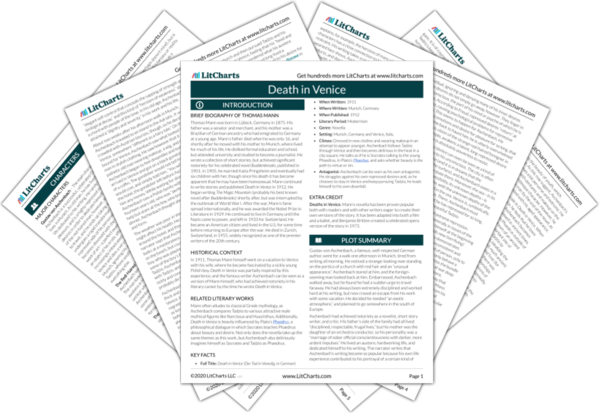Summary
Analysis
Aschenbach had achieved fame and notoriety as a novelist, short story writer, and critic. His father’s side of the family had been “officers, judges, bureaucrats,” with “disciplined, respectable, frugal lives.” His mother had been the daughter of an orchestra conductor, so that he was the result of “the marriage of sober official conscientiousness with darker, more ardent impulses.”
Aschenbach had always been “bent on fame,” and established a successful literary career early in his life. He had always worked hard and “had never known idleness, never known the carefree recklessness of the young.” Once someone at a social gathering said of him that he only lived his life like this (as the person clenched his fist), never like this (as he let his hand open at ease).
Aschenbach grew up without any real friends, and always hoped to live a productive life. He possessed both talent and discipline, and still kept a rigid daily working schedule at the age of fifty. He had accomplished his great works through “short daily stints,” during which he dedicated his “greatest strength and dignity” to his writing.
The narrator reflects that there needs to be a “congruence” between an artist and his generation in order for a great work of art to be made. This “natural bond of shared feelings” is the real reason why people “confer fame on a work of art.” In one of his works, Aschenbach had written that everything is “brought to completion despite distress and torment, poverty, abandonment, physical weakness, vice, passion, and a thousand obstructions.” This was indeed true of Aschenbach’s own life experience.
The narrator emphasizes the links between an artist’s life and work, and between art and the lives of those who view, read, or experience it. The peculiar quality of Aschenbach’s writing is intertwined with his own life experience. His seemingly out-of-character vacation will affect not only him, then, but also his writing.
Themes
Get the entire Death in Venice LitChart as a printable PDF.

An analyst wrote of Aschenbach that he often wrote of a hero that stood in for “an intellectual and youthful masculinity that grits its teeth. . . while its body is pierced by swords and spears.” Throughout his work one could find “the elegant self-control that conceals the sapping of strength and biological decay.” This kind of “heroism of weakness” resonated with the people of the time.
Aschenbach had captured “passionate, absolutistic” youth in his early works, which questioned the nature of art and the role of the artist. His later works had moved toward a “new dignity and severity.” As he grew older and outgrew “the chrysalis of libertinism,” he became more of a conservative and traditional writer. He had settled down in Munich, married, and started a family.
Aschenbach’s writings have changed as he has changed over the course of his life. He has established a conservative, traditional life that has tempered his formerly “passionate” work. But under the surface, does he want something more than “dignity and severity”?
Themes
Aschenbach was short and dark-haired. His furrowed brow and face showed signs of wear not from a difficult life but from writing. The narrator describes art as “an enhancement of life,” and says that it “wears you out faster.”












